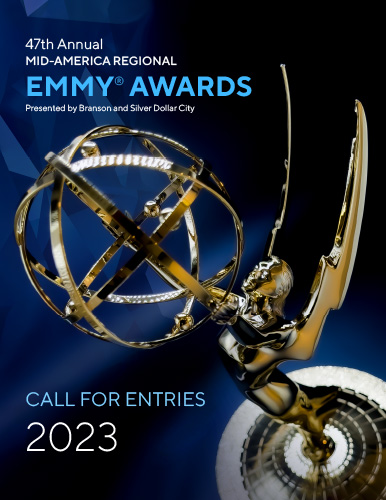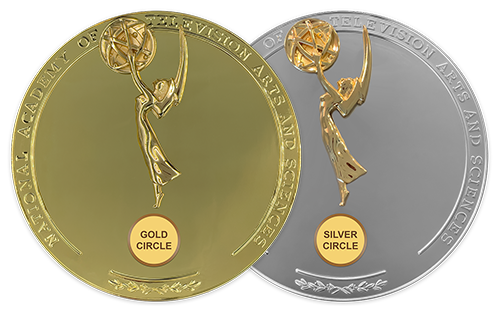47th Annual
MID-AMERICA REGIONAL
EMMY® AWARDS
Presented by Branson and Silver Dollar City
2023
ELIGIBILITY PERIOD
April 1, 2022 — March 31, 2023
ENTRY PERIOD
March 1, 2023 — May 5, 2023
Regional EMMY® NOMINATIONS
August 10, 2023
Regional EMMY® AWARDS
Ceremony
September 30, 2023
Branson Convention Center, Branson, MO
THE NATIONAL ACADEMY OF TELEVISION ARTS & SCIENCES
The National Academy of Television Arts & Sciences Awards Committee determines policy for all NATAS awards competitions. The Call for Entries Awards manual reflects our ever-changing industry and is forward looking with terms, rules and categories. All regional chapters adhere to the same standard contest rules as outlined in our Call for Entries; and, while each chapter may select different categories based on what they feel is most appropriate for their region, the category titles and definitions are the same across chapters.
ELIGIBILITY AREA
All broadcast, cable, broadband, cable / community / government access and video content providers (not close circuit or venue specific) located within the following Designated Market Areas (DMAs):
- St. Louis
- Kansas City
- Little Rock
- Springfield (MO)
- St. Joseph
- Columbia/Jefferson City
- Joplin/Pittsburg
- Quincy/Hannibal/Keokuk
- Ottumwa/Kirksville
- Davenport/Rock Island/Moline
- Paducah/Cape Girardeau/Harrisburg
- Champaign/Springfield/Decatur
- Fort Smith/Fayetteville/Springdale/Rogers
- Jonesboro
- Monroe-Eldorado and Shreveport (LA)
ABOUT CATEGORIES
Added
#208 — Live Sporting Event Game
#312 — Entertainment – Short Form (for performances)
#326 — Government/Politics Long Form
GONE THIS YEAR
Live News Producer
DID YOU KNOW?
#106. Weekend Newscast - All Markets
This is for day and evening weekend newscasts.
CATEGORY VIABILITY RULE
If the Mid-America Emmy® Awards Committee deems a category non-viable due to insufficient number of entries, the category may be canceled or merged with another similar category. If a category is merged, submitters will be notified and given a choice of withdrawing the entry and having the fee refunded, or, leaving the entry to be judged in the merged category.
We encourage you to thoroughly read through the rules and category descriptions this year. Don’t risk having your entry disqualified because you didn’t read the rules.
ENTRIES
CHANGES TO ENTRIES
DURING THE ENTRY PROCESS
During the entry process the only thing you can’t do is change a category or delete an entry.
The Emmy® office will do this for you.
Just ask.
AFTER THE ENTRY PROCESS
You are responsible for the correct information on the entry form; changes/corrections/additions after the entry deadline and before Nominations are announced will result in a $25 fee.
Proof your “Confirmation of Entry” email details for accuracy and inclusion before the deadline. And please, turn off ALL CAPS before typing.
DO NOT USE ALL CAPS ON YOUR ENTRY!
PREPARING YOUR ENTRY
EMMY® EXPRESS
Entries must be submitted and videos must be uploaded through EMMY® EXPRESS.
MAKE TITLES SHORT
Entry titles should be five words or less. Title + Maximum length = Five Words or less. Why? Because it looks and fits better on the statuette that you hope to take home.
SECOND OF BLACK RULE
- One (1) second of black must be inserted between elements of a composite.
- One (1) second of black must be inserted between elements of a series entry or between excerpts if the original video has been edited to fit the entry time limit for the category.
REMINDER OF TERMS
- News Single Shift is for stories shot, edited and aired in a single shift – a day turn.
- News No Time Limit refers to the time spent producing the story not the length of the story itself. These categories are for stories you worked on over multiple days.
- Short Form Content is non-news material that runs up to ten minutes in length – material that used to be entered in the Program Feature or Segment categories or short stand-alone content.
- Long Form Content is non-news material longer than ten minutes, including traditional 30 and 60-minute programs.
- News Content is journalistic material from news departments at TV stations, newspapers, and online news reporting organizations. (While News Content is generally not permitted in the Short and Long Form Content categories, shows and specials produced by news organizations should be entered in an appropriate Long Form Content category.)
JUDGING
Judging agreement: submission of an entry constitutes an agreement that each entrant listed on the entry will serve as a peer judge on at least two panels in the next 12 months (calendar year 2023).
There will be judging opportunities from other NATAS chapters from March-October 2023. Entrants will be notified via email blasts when judging is available. To sign up, login to your EMMY® EXPRESS dashboard to see available panels. Select a panel and request to be added to the panel.
FEES
MEMBERSHIP FEES
ANNUAL MEMBERSHIP FEES
Fee: $75
Membership must be current to receive the entry fee discount.
MEMBERSHIP
MEMBERSHIP IS IN THE NAME OF THE INDIVIDUAL, NOT THE CORPORATION OR BUSINESS.
The membership process is completely integrated with your entries.
Complete the member application only once and BEFORE you enter. You will be able to manage/update your membership information very easily by following the prompts in the Member Dashboard.
Membership fees are paid through Paypal.
Become/Renew membership BEFORE entering and paying for entries.
NOTE: There are no refunds for entry overpayments.
NOTE TO JUDGES: Individuals who judged 2+ times during the eligibility period 1/1/2022-12/31/2022 will automatically receive a $10 discount from each of his/her entry fees.
ENTRY FEES
ACTIVE MEMBER ENTRY FEE
$95 for first entrant name
$75 for additional names listed, per entry
NON-MEMBER ENTRY FEE
$225 for first entrant name
$200 for additional names listed, per entry
CHANGES TO WORDING ON AN ENTRY AFTER DEADLINE $25
Entrants may make changes to their entries (such as title changes, spelling corrections, description changes) up to the final May 5 deadline.
After May 5th the office must make the changes; these are the fees: $25 per entry.
ENTRY PAYMENTS
Entry Payments can be made via PayPal or check.
MAKE CHECKS PAYABLE TO “NATAS Mid-America” and MAIL TO:
NATAS Mid-America
3655 Olive St
St. Louis, MO 63108
All Payments are due MAY 15, 2023.
PLEASE REMEMBER:
Member and Entry fees must be paid separately
ADDITIONAL CHARGES AND EXTENUATING CIRCUMSTANCES
If extenuating circumstances result in a qualified name being left off an entry, the name may be added to entry after Nominations are announced provided these criteria are met: a letter detailing the circumstances must be emailed to the office not later than five days after nominations are announced. If approved, the entry fee is $500 per name.
REMEMBER
To be eligible ALL entries must be submitted through EMMY® EXPRESS and all videos must be uploaded.
QUESTIONS?
The Mid-America cell phone number is: 314-533-2993
Please call with any questions or email: maggie@emmymid-america.org
- MP4 USING H.264 VIDEO CODEC AND AAC AUDIO CODEC
- For best quality, encode your video at its original size
- Sizes 1920×1080 or 1280×720 are recommended
- Your video should be at least 720p
- Entrants are responsible for the technical quality of their videos
- Quicktime (MOV) files that use the Apple Intermediate Codec (used in Final Cut Pro)
- DRM protected files from Microsoft (WMV) or the iTunes Store (M4V, MOV)
- WMV videos using the MSS2 video codec (for screencasting)
2023 CALL FOR ENTRIES
EMMY® Categories
MID-AMERICA SCHEDULE
Eligibility Period
April 1, 2022 – March 31, 2023
ENTRY DEADLINE
May 5, 2023
ENTRY VIDEO UPLOAD DEADLINE
May 5, 2023
scholarshipS
CAREER GRANT for PROFESSIONALS
Continuing Education Opportunity Grant C.E.O.G
Applications Deadline
April 30, 2023
Awards Store

Contact US
If you have any questions, contact us at:
314-533-2993 / maggie@emmymid-america.org

Mid-America Regional EMMY® Awards
Contest Rules
- St. Louis
- Kansas City
- Little Rock
- Springfield (MO)
- St. Joseph
- Columbia/Jefferson City
- Joplin/Pittsburg
- Quincy/Hannibal/Keokuk
- Ottumwa/Kirksville
- Davenport/Rock Island/Moline
- Paducah/Cape Girardeau/Harrisburg
- Champaign/Springfield/Decatur
- Fort Smith/Fayetteville/Springdale/Rogers
- Jonesboro
- Monroe-Eldorado and Shreveport (LA)
- Local station news coverage that may receive national exposure should be submitted to regional Emmy® Award competitions.
- A documentary film that has a limited theatrical release at film festivals (showing on 50 or fewer screens in the U.S. over a one-year period) before telecast or being made available online is eligible provided the program content is produced and intended for the regional or local audience. Documentary films with a theatrical debut more than one year prior to their television or streaming debut will not be eligible.
- Local content that later receives national distribution may be submitted to either a regional or a national awards competition, but not both.
- Local segments that are eligible to participate as entries in National Emmy® Award competitions (i.e. News & Doc) may compete in both regional and national awards competitions under prevailing rules.
- Subject matter must be regionally or locally focused rather than national or global in scope.
- If the content or program has been submitted into any of the NATAS national competitions in a previous or current awards cycle, it may no longer be submitted regionally.
- Company/individual has entered other similar content into NATAS national competitions.
- If the program or content has been promoted to/marketed to a national audience or produced in association with a national media brand, it may not be entered regionally.
- All promotional and craft-category submissions associated with the content must be submitted to the same competition.
- Content may only be submitted to a single competition. A program submitted to a regional competition may not then be submitted to a national competition or another regional competition.
- All craft-category submissions associated with the content must be submitted to the same regional or national competition.
- Eligibility for a regional competition is determined by the date the production was first telecast or made available online or via VOD in a region.
- Eligibility for a national competition is determined by the date the production was first telecast or made available online or via VOD nationally.
- Pornographic, violent, defamatory or offensive content.
- Previously distributed programs, series or related craft content which was distributed and met eligibility requirements during a previous awards year or another Emmy® competition.
- Program length commercials or infomercials.
- Closed circuit content or internal communications.
- No content produced or created for a regional or national Emmy® awards show may be submitted to an Emmy® awards contest. Related craft material is also ineligible.
- Motion picture content that premiered in general release to the public in theaters.
- Compilation reels, “clip shows” or “best of…” programs that were edited from original content.
- Any acquired foreign productions not originated in the United States.
- No entry may be submitted to more than one Emmy® awards competition (Regional or National).
*Exception: Regional Emmy® recipients in the Breaking News and Investigative Report categories are eligible for submission to the National News & Documentary competition under prevailing rules. - Different episodes from the same program or series can only be entered in one Emmy® Awards competition
- Entrants are not allowed to separate content from individual craft achievement and submit in multiple Emmy® Awards competitions.
- If the Chapter deems content ineligible, craft submissions related to that content would also be ineligible.
- The first distribution of the entry is the primary determination of eligibility.
Mid-America Regional EMMY® Awards
CATEGORIES
#100 SERIES
101 · Morning / Daytime Newscast — Markets 1-49
102 · Morning / Daytime Newscast — Markets 50+
103 · Evening Newscast — Markets 1-49
104 · Evening Newscast — Markets 50-99
105 · Evening Newscast — Markets 100+
106 · Weekend Newscast — All Markets
107 · News Special
108 · Daily News Report — Single Shift
109 · Hard News Report — No Production Time Limit
110 · Breaking/Spot News — Single Report
111 · Breaking/Spot News — Multiple Reports
112 · Continuing Coverage
113 · Team Coverage
114 · Investigative — Single Report
115 · Investigative — Multiple Reports
116 · News Feature — Light Feature (Single Report or Multiple Reports)
117 · News Feature — Serious Feature (Single Report or Multiple Reports)
118 · Arts/Entertainment — News
119 · Business/Consumer — News
120 · Crime/Justice — News
121 · Diversity/Equity/Inclusion — News
122 · Education/Schools — News
123 · Environment/Science — News
124 · Health/Medical — News
125 · Historical/Cultural — News
126 · Human Interest — News
127 · Military — News
128 · Politics/Government — News
129 · Religion — News
130 · Societal Concerns — News
131 · Weather — News
132 · Weathercast
#200 SERIES
201 · Sports Story — News
202 · Sports Story — Short Form Content
203 · Sportscast
204 · Sports Interview/Discussion
205 · Sports Program — Live
206 · Sports Program — Post-Produced or Edited
207 · Sports — One-Time Special
208 · Live Sporting Event/Game
#300 SERIES
301 · Documentary — Cultural
302 · Documentary — Historical
303 · Magazine Program
304 · Public Affairs Program
305 · Special Event Coverage — Live
306 · Informational/Instructional — Short Form Content
307 · Informational/Instructional — Long Form Content
308 · Interview/Discussion — Short Form or Long Form Content
309 · Branded Content — Short Form Content
310 · Branded Content — Long Form Content
311 · Arts/Entertainment — Short Form Content
312 · Entertainment — Short Form Content
313 · Arts/Entertainment — Long Form Content
314 · Business/Consumer — Short Form Content
315 · Diversity/Equity/Inclusion — Short Form Content
316 · Education/Schools — Short Form Content
317 · Environment/Science — Short Form Content
318 · Health/Medical — Short Form Content
319 · Historical/Cultural — Short Form Content
320 · Human Interest — Short Form Content
321 · Human Interest — Long Form Content
322 · Lifestyle — Long Form Content
323 · Religion — Short Form Content
324 · Societal Concerns — Short Form Content
325 · Politics/Government — Short Form Content
326 · Politics/Government — Long Form Content
#400 SERIES
401 · Public Service Announcement — Single Sport or Campaign
402 · Promotion — News - Topical (Single Spot)
403 · Promotion — News - Image/Campaign
404 · Promotion — Program (Single Spot)
405 · Promotion — Program - Image Promo or Promo Campaign
406 · Promotion — Sports
407 · Commercial — Single Spot
408 · Commercial — Campaign
#500 SERIES
501 · Overall Excellence
502 · News Excellence
503 · Community Service
504 · Journalistic Enterprise — Individual
#600 SERIES
601 · Anchor — News
602 · Anchor — Weather
603 · Anchor — Sports
604 · Reporter — Live
605 · Program Host/Moderator
606 · Writer — News, Short Form or Long Form Content
607 · Writer — Short Form or Long Form Content
608 · Director — Live or Recorded Live
609 · Director — Short Form or Long Form Content
610 · Editor — News
611 · Editor — Short Form or Long Form Content
612 · Photographer — News
613 · Photographer — Short Form or Long Form Content
614 · Multimedia Journalist
615 · Graphic Arts — Motion Graphics and Visual Effects
616 · Audio — Live or Post Production
617 · Musical Composition/Arrangement
NEWS CONTENT
News content categories are intended for journalistic material produced by news departments within television stations, newspapers or online news reporting entities.
Producers should be the primary entrants for these categories. Qualified others may be eligible if their contributions are significant to the entry’s award-worthiness. Submitters who created work as part of media pool coverage can only enter their material once and must clearly identify their contributions on the entry.
For single News entries, the original video and submission length must not exceed 10 minutes.
Multi-part news series entries are eligible and must include a minimum of two (2) but no more than five (5) separate reports from the series. Total submission time limit for News series entries may not exceed 15 minutes.
NOTE: One (1) second of black must be inserted between elements of a series entry or between excerpts if the original video has been edited to fit the entry time limit for the category.
Sports CONTENT
Producers should be the primary entrants for Sports Content categories. Qualified others may be eligible if their contributions are significant to the entry’s award-worthiness.
Sports News content is only eligible in the appropriate News subcategories.
For Short Form Content and Sportscast entries, the original video must not exceed 10 minutes.
Series entries are eligible and must include a minimum of two (2) but no more than five (5) separate segments from the series. Total submission time limit for News and Short Form Content series entries may not exceed 15 minutes.
For Program entries, no more than three (3) excerpts may be included to bring longer content to the 30-minute entry time limit (exception: Sports - One-Time Special) Excerpts must be presented in original, chronological order.
CHAPTER NOTE: One (1) second of black must be inserted between elements of a series entry or between excerpts if the original video has been edited to fit the entry time limit for the category.
PROGRAMMING CONTENT
Producers should be the primary entrants for Programming Content categories. Qualified others may be eligible if their contributions are significant to the entry’s award-worthiness. Submitters who created work as part of media pool coverage can only enter their material once and must clearly identify their contributions on the entry.
Unless otherwise noted, the time limit for any program or long form content category is 30 minutes. A maximum of three (3) segments/excerpts is permitted to bring longer programs to the required entry time limit. For program series or long form series entries, the entry must include excerpts from at least two (2) episodes from the series.
Short Form content must be submitted in its entirety as originally distributed. The original video and submission length must not exceed 10 minutes.
News content is only eligible in the appropriate News categories.
CHAPTER NOTE: One (1) second of black must be inserted between elements of a series entry or between excerpts if the original video has been edited to fit the entry time limit for the category.
SPOT ANNOUNCEMENTS
For excellence in promotional, commercial or public service announcements. Entries must be regionally conceived, produced and distributed. Spots that contain more than 50% of network or syndicator-provided material do not qualify. Music, graphics and pre-edited video constitute such material. Spots may be 5 seconds to 2 minutes in length, except for the Long Form Promotional Spot category. If a campaign is entered, a maximum of five (5) spots may be included which are edited together for a single video upload. If a campaign is entered, no spots from that same campaign may be submitted in a single-spot category.
CHAPTER NOTE: One (1) second of black must be inserted between elements of a campaign.
SPECIAL ACHIEVEMENT
A statuette is awarded only to the eligible recipient(s) in each category. Others who may have contributed to the content and execution of the material presented in the entry may purchase plaques to commemorate their participation.
An entry submitted in a Special Achievement category may not be duplicated in its entirety in any other Special Achievement category.
CRAFT Achievement
For excellence in a specific craft discipline demonstrating the skills of one or more individuals. Each entry may contain a single example of the craft, or a composite of material as originally distributed. While craft entrants may submit more than one entry per craft discipline, only one of those entries may be a composite. Elements of the composite may not be separately entered as individual craft entries in the same craft category. Craft awards are intended for hands-on craft persons, not those who supervise craft persons.
CHAPTER NOTE: One (1) second of black must be inserted between elements of a composite.
CHAPTER NOTE: A composite is a sampling of a minimum of two (2) and no more than five (5) representative segments or examples of work that convey to a judging panel the scope, breadth, or range of an individual’s talents within the specified craft category. The elements within a composite, unless otherwise noted in the category description, are to be “as aired” with no post-distribution changes, such as additional edits, music or special effects. Composites may include stories or segments in their entirety and/or excerpts from longer content. One to two seconds of black between cuts, with no audio or slates, must be added to separate segments within the composite.
A segment is an excerpt from a news program (newscast, news special, breaking news, live sporting event/game, etc.) with material that doesn’t include the entrant edited out. An entry may include up to five segments. Each segment may include material from only ONE program: think of this as “five segments equals five changes of clothing” rule. It’s allowed, but not required, for the co-anchor’s and reporters’ video to be edited out of a segment. Anchor entries may include examples of studio anchoring, field anchoring, specials, breaking, etc., but NOT reporter packages (if an anchor also does reporter packages, they must enter those in one of the reporter categories.)
GLOSSARY OF TERMS
(also see: Craft Category)
(also see: Content Category)
- Serving as an “overseer” of the content, determining the overall tone, structure, look, sound, and mission of the content.
- Making strategic editorial decisions that have a significant impact on the resulting content.
- Identifying interview subjects and shoot locations.
- Scheduling interviews, shoots, and edits.
- Writing and/or approving scripts.
- Formulating ideas for graphics/animations and working with designers through completion.
- Working with editors to assure the content meets expectations and overseeing necessary changes.
- For studio-based programs or content, the producer would generally fulfill much of the above and/or oversee control room decisions, timing, etc.
- Clients, Sponsors, Underwriters, Funders, Distributors.
- CEOs, Presidents, Vice Presidents, Company Owners, General Managers with no hands-on role in the video production.
- News Directors and Executive Producers with no hands-on role in the video production.
- Support staff or management with no hands-on role in the video production.
- People or organizations that are the subject of the video, including interviewees.
- People or organizations that provide resources (archives, photos, film, location access, etc.) for and/or during the production.

